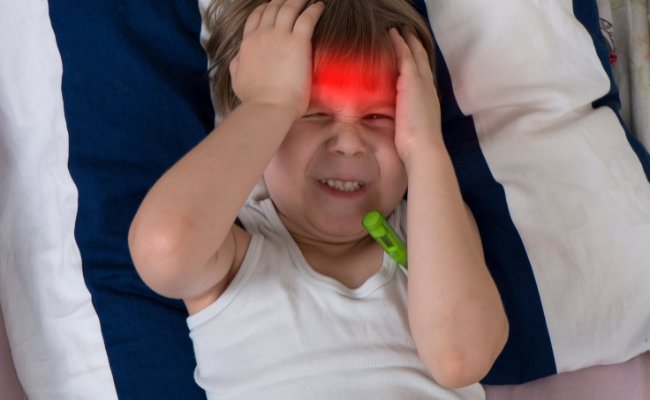How to Treat Headaches In Children?
- December 01, 2023
- No Comments

What is Headaches in Children?
Headaches in children, although not as extensively discussed as those in adults, pose a prevalent concern for parents and caregivers. Recognizing the signs and symptoms is vital for effective management, considering that children can encounter various types of headaches, such as tension headaches, migraines, and cluster headaches, which are the most common. Accurate identification is paramount as each type requires a distinct treatment approach.
Childhood headaches present as pain in the face or head, impacting 25% of younger children and a substantial 75% of adolescents. Notably, migraines stand out as one of the top five most widespread diseases in children. It's crucial to emphasize that headaches, boasting over 150 distinct types, are pervasive in both adults and children alike.
Why Headaches in Children occur?
Understanding the underlying causes of headaches in children is fundamental to formulating effective treatment plans. Several factors contribute to headaches in this demographic:
- Genetics: A family history of headaches can predispose children to experiencing them. Genetic factors influence an individual's susceptibility to migraines or tension headaches.
- Environmental Factors: Children, particularly those who are sensitive, may be triggered by environmental elements. Bright lights, loud noises, or strong odors can act as stimuli for headaches.
- Dehydration: Children may not always recognize their need for water, leading to dehydration—a common trigger for headaches. Ensuring adequate fluid intake is essential.
- Lack of Sleep: Irregular sleep patterns or insufficient sleep can contribute to headaches in children. Establishing a consistent sleep routine is crucial for preventing this trigger.
- Stress: Children can experience stress from various sources such as school, peer relationships, or family dynamics. Stress-induced tension headaches are not uncommon in this age group.
- Screen Time: With the rise of digital devices, prolonged screen time has become a potential contributor to headaches in children. Extended exposure can strain the eyes and trigger discomfort.
How to Manage and Prevent Headaches in Children
Effective management and prevention of headaches in children require a multifaceted approach involving lifestyle adjustments, trigger monitoring, and professional guidance when necessary.
- Establish a Routine: Children thrive on routine. Consistent sleep schedules and regular meal times contribute to overall well-being, reducing the likelihood of headaches.
- Hydration: Encourage regular water consumption to prevent dehydration. An adequate fluid intake supports overall health and helps stave off headaches.
- Balanced Diet: Provide a well-balanced diet rich in nutrients. Certain dietary factors, such as skipping meals or consuming specific foods, can contribute to headaches.
- Manage Stress: Teach children stress-management techniques. Simple practices like deep breathing, mindfulness, or engaging in calming activities can help alleviate stress-induced headaches.
- Limit Screen Time: Set reasonable limits on the use of electronic devices. Incorporate breaks to reduce eye strain and the potential for headaches associated with extended screen exposure.
- Identify Triggers: Maintain a headache diary to track potential triggers and patterns. Identifying specific causes is crucial for implementing targeted preventive measures.
- Regular Exercise: Physical activity has been linked to a reduction in the frequency and intensity of headaches. Encourage age-appropriate exercise to promote overall well-being.
- Regular Eye Checkups: Undiagnosed vision issues can contribute to headaches. Regular eye checkups ensure that any visual impairments are addressed promptly.
- Create a Relaxing Environment: Foster a calm and comfortable environment at home. Minimize potential stressors and create a space where a child can relax and unwind.
Treatment Solutions:
When a child experiences a headache, prompt and appropriate treatment is crucial. Distinguishing between different types of headaches is essential for determining the most effective approach.
- Tension Headaches: Encourage relaxation techniques, such as deep breathing exercises or gentle massage.Ensure the child gets adequate rest and sleep.Over-the-counter pain relievers, as recommended by a healthcare professional.
- Migraines: Identify and avoid triggers by referring to the headache diary.Provide a quiet, dark room for the child to rest.Over-the-counter or prescription medications, as advised by a healthcare professional.
- Cluster Headaches: Consult with a healthcare professional for a comprehensive evaluation.Prescribed medications to manage and prevent cluster headaches.Oxygen therapy under medical supervision.
Benefit Points:
Implementing a comprehensive approach to treating headaches in children can lead to several positive outcomes:
- Improved Quality of Life: By addressing and managing headaches, children experience an improved overall quality of life, with fewer disruptions due to pain and discomfort.
- Enhanced Academic Performance: Reduction in headache frequency and severity positively impacts a child's ability to focus and perform well academically, contributing to their overall success in school.
- Development of Healthy Habits: Teaching children about the importance of factors like hydration, regular sleep, and stress management contributes to the development of lifelong healthy habits that extend beyond childhood.
- Increased Emotional Well-being: Effective headache management helps reduce the emotional toll that frequent headaches can take on a child. This, in turn, promotes emotional well-being and resilience.
- Empowerment Through Knowledge: Both parents and children feel empowered through understanding the triggers and effective management strategies for headaches. This knowledge creates a sense of control over the situation, fostering a proactive approach to health.
Comments (0)